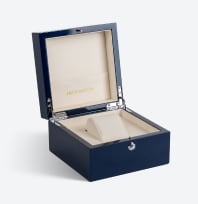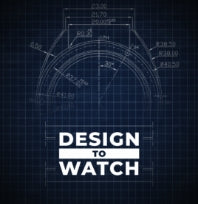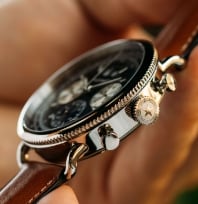Chronograph watches are some of the most well-crafted and interesting watches on the market. They are intricate pieces of human craftsmanship that can be used for a lot more than telling you the time.
In a world of smartwatches, many people have forgotten just how useful and practical a chronograph watch can be. It not only functions as a timepiece, but you can also use it as a stopwatch, to measure time, speed, or distance, and more.
Here, we’re going to explain to you what a chronograph watch is, how it works, how to use one, what to look for in a chronograph watch, and where you can buy one for yourself.
History of the Chronograph Watch
Chronograph watches have been part of watchmaking for a long time. The first recorded chronograph was invented by a Frenchman named Louis Moinet in 1816. The watchmaker invented the new technology to use in astrology, as it could measure time more precisely than most watches of the time—down to 1/60th of a second.
However, his first chronograph watch never went to market. The first publicly-marketed chronograph came about a few years later in 1821.
Nicolas Mathieu Rieussec, a watchmaker for King Louis XVIII, iterated on the concept by using two different watch faces. The king wanted to be able to time the laps of horse races, so Rieussec’s watch used the power reserve from one face’s movement in order to move a needle around the other. That needle was covered in ink so that it could mark the elapsed time.
This was a little impractical, though, so by the mid-1800s other inventors had created chronographs that could be reset, removing the waste of ink. During this time, chronometers functioned only as stopwatches, but they were revolutionary.
Before this invention, it was impossible to time things to such a precise degree. Runners could know exactly how long their laps took, pushing them to get faster and faster times. In addition, the military began using the chronograph function extensively.
Once we get to the early 1900s, you start seeing wristwatches with built-in mechanical chronograph functionality. Breitling was one of the first companies to include a separate stopwatch function on the side of the watch for operating the chronograph hand.
Around this time, you also start seeing the introduction of new complications like the tachymeter, automatic chronograph watches, and more and more watchmakers creating their own versions.
What Is a Chronograph Watch?
Modern chronographs differ slightly from those made in the 1800s, but the core concept remains the same. At its most basic, “chronograph” is just another word for a stopwatch. However, there are lots of other features built into modern chronographs that make them more useful than stopwatches.
Most chronographs feature at least a few dials within the watch face and three buttons on the right-hand side of the face. Take a look at our Pursuit Chronograph as an example.
The three dials on the face cover three different measurements of time—hours, minutes, and seconds. The placement of these dials differs from watch to watch, but typically you’ll see these three, at least.
On the right side, there is a crown typical of any timepiece, but there are two additional buttons. These function as a start-stop and a reset for the stopwatch feature.
Although many people are used to having a stopwatch at all times on their smartphone, chronographs were necessary for keeping accurate time not that long ago. Not to mention, they look as classic as ever.
With some chronographs, you will also find additional complications. These include tachymeter scales for measuring distance, a way to measure your heart rate, date windows, and other useful tools.
How Do Chronograph Watches Work?
The only thing a watch really needs to be called a chronograph is a second hand that moves independently of the timekeeping function. If that hand can be started, stopped, and reset, then you have a chronograph.
The inner-workings of a chronograph watch are similar to other quartz watches with one key difference. Chronographs have to have additional systems and mechanisms to control each of the functions or complications of the watch.
This is why chronographs are often more expensive than other kinds of watches. They have a lot more moving parts, and watchmakers have to make sure these mechanisms do not interfere with each other.
Chronographs keep time in the same as any other watch, building tension on a mainspring that slowly releases to move the gears and keep time. However, a chronograph watch has multiple systems within the timepiece to track different sets of time. Usually, there are at least two, if not more.
How to Use a Chronograph Watch?
One of the questions we get the most is how to actually make use of a chronograph watch. Many people have them, but they end up just using them as a normal watch. That’s fine, but you’re really missing out on lots of features that a chronograph watch offers.
Below are just a few of the different ways you can make use of unique features of a chronograph.
Stopwatch
The first and most common feature among all chronograph watches is a stopwatch. By using the two additional buttons on the side of the watch, you can start, stop, and reset this function.
In some, this will be an extra hand that goes around the face of the watch, but typically this will use the dials on the face. The second hand will start counting first, followed by the minutes and the hours.
This may not seem very useful in the age of smartphones, but this was incredibly important for many people back in the day. Those in the military would use chronographs to time artillery strikes or to see how long it took to get from one place to another.
Tachymeter
Although this isn’t found in all chronographs, lots of them will have this feature. A tachymeter is made as a rotatable bezel that is used to measure speed and distance.
This was most commonly used by athletes timing their races. If you know the time and the distance, you can use the tachymeter to calculate your speed. In addition, if you know time and speed, you can also use it to calculate your distance.
The number on the tachymeter may not make sense initially, but there are easy formulas you can use to do your calculations.
If you travel one mile in 60 seconds, that will correspond to 60 on the tachymeter, as well, meaning that you’ve traveled at 60 miles per hour. [a]
If you’re trying to measure distance, it works in a similar way. You just have to know the speed at which you’re traveling. So using the same example, if you know you’re going 60 miles per hour, when you stop it at 60, the distance you’ve traveled will be one mile.
There are some bezels that rotate, allowing the wearer to do multiple calculations simultaneously. This is not found on all chronographs, but you’ll see it pretty often.
What to Look for in a Chronograph Watch?
When it comes to buying a chronograph watch, there are a few things you should keep an eye out for. Each of these will be important when choosing which watch you want to purchase.
Quality
Make sure you’re buying something that is going to last you. If you want to go buy a $20 watch that will last a few months, that’s fine, but if you’re going to spend any significant amount of money on a chronograph watch, buy something that’s well-made.
For example, all Jack Mason watches are made with sapphire crystal, genuine Italian leather straps, and come with a warranty for the lifetime of the watch.
We want you to have a luxury watch that you can treasure and pass down to your children and grandchildren. That’s part of the beauty of owning a quality timepiece.
Complications
Know what complications you’re getting in your chronograph watch. If you just want the stopwatch feature, then don’t spend the extra money for extra complications.
However, if you want to use the watch to measure speed or distance, you’ll want to make sure it has a built-in tachymeter. This just comes down to your personal preference.
Price
The pricing of luxury watches is complicated. You don’t want to spend so little that you get something low-quality, but you can easily start spending far too much money just because of a brand name associated with a particular watch.
Find something that fits your price point and offers a good value for what you’re getting. Some expensive watches are worth the higher price tag, but you can often get the same quality at a much more affordable price.
Appearance
And last but not least, you want to be sure you like the way the watch looks. At Jack Mason, we believe that the dress watch a man chooses to wear not only reflects who he is, but it also helps to create the legacy of who he wants to be.
If you don’t like the way the watch looks, you won’t wear it. And why spend so much money on something just because it has a specific name attached to it?
As with so many other things, just make sure you buy what you like. Our Halyard Chronograph with Swiss Superluminova markings and a stainless steel case is one of our favorites, but if it doesn’t suit your style, you should find a watch that will.
Sources-
https://www.heddels.com/2018/01/history-of-the-chronograph-2/
https://www.realmenrealstyle.com/luxury-watches/








